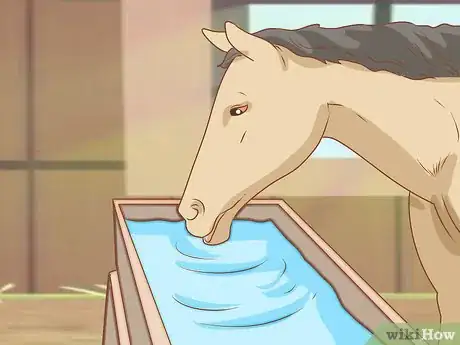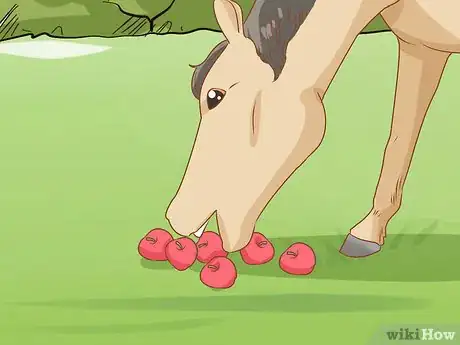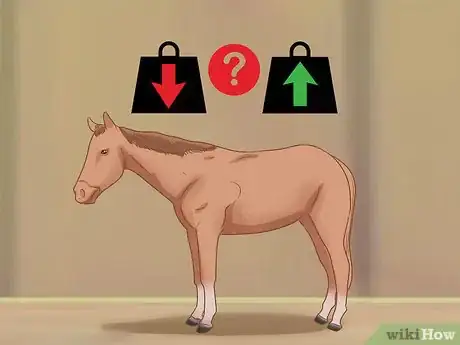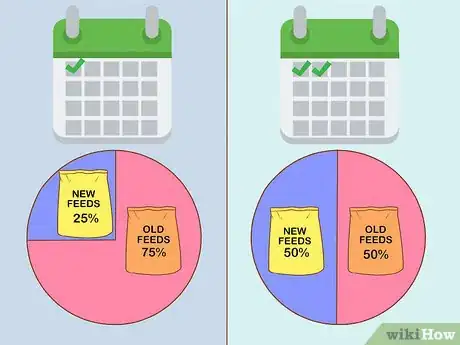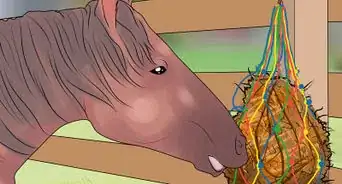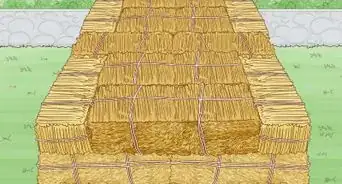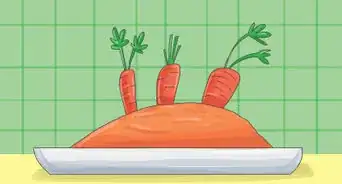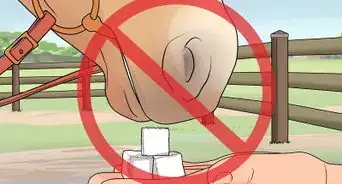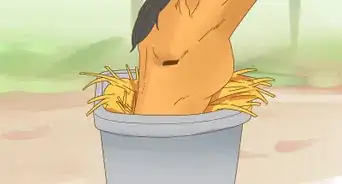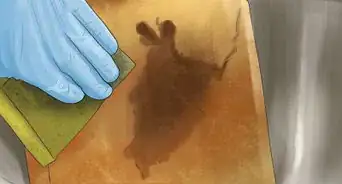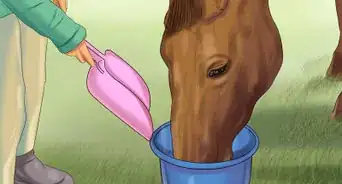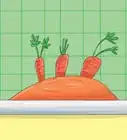This article was co-authored by Alana Silverman. Alana Silverman is a Certified EAGALA (Equine Assisted Growth and Learning Association) Equine Specialist and the Assistant Manager of Paddock Riding Club, a 200-horse premier equestrian facility based in Los Angeles, California. Alana has over 25 years of experience caring for and riding horses and specializes in English riding and riding instruction. She has a BA in Psychology from the University of Arizona.
There are 7 references cited in this article, which can be found at the bottom of the page.
wikiHow marks an article as reader-approved once it receives enough positive feedback. In this case, 84% of readers who voted found the article helpful, earning it our reader-approved status.
This article has been viewed 277,767 times.
Feeding a horse can be confusing. There are a large number of different feeds available and no two horses are alike. The amount and type of feed given will depend on the horse’s type, age, weight, health, workload, the climate and what is locally available. Keep reading to learn how to feed a horse.
Steps
Understanding a Horse’s Nutritional Needs
-
1Provide your horse with plenty of fresh, clean water. Horses require between 5–15 gallons (18.9–56.8 L) of water per day. If possible, make sure that your horse has access to water at all times. Otherwise, make sure that you water your horse at least twice per day and allow several minutes for your horse to drink.[1]
- Make sure that the water in your horse’s trough is clean and not frozen. Keep the trough clean as well by hosing it out every day.[2]
-
2Provide your horse with plenty of structural carbohydrates. Structural carbohydrates, like hay and grass, are essential to a horse’s diet.[3] Horses eat large quantities of hay and grass as their main source of food. In fact, horses should eat about 15-20 pounds or 1-2% of their body weight in hay every day, so make sure that your horse always has plenty of hay to chew on.[4]
- Make sure that the hay you feed your horse is free of mold and dust.[5]
Advertisement -
3Provide your horse with nonstructural carbohydrates in moderation. Nonstructural carbohydrates, like oats, corn, and barley, are also essential to a horse’s nutrition. Provide small amounts of grain to your horse throughout the day. Every day, horses can also have ½ pound of grain per 100 pounds of body weight. Feed grain to your horse in two or three evenly spaced feedings during the day.[6]
- Make sure to measure the portions that you feed your horse to make sure that you are giving her the correct amount.[7]
- If the weather is hot, feed grain to your horse during the cooler hours of the day, such as early in the morning and later in the evening.
-
4Supplement your horse’s diet with feed to provide protein, fat, vitamins, and minerals. Although your horse will get most of its calories from hay and grass, you should feed your horse some fortified feed each day to help meet any nutritional gaps. Protein, fat, vitamins, and minerals are important parts of your horse’s nutrition, but they are not required in large amounts.[8]
-
5Supplement as needed. If you think your horse is not getting all of the necessary vitamins and minerals from feed, then you can supplement with special vitamins for horses. Just be careful not to overload your horse with too many vitamins. An excess of vitamins can cause problems just like a deficiency of vitamins can.[9]
-
6Give treats in moderation. Giving treats to your horse when you want to reward her is a great way to bond with your horse as well. Just make sure that you do not overdo it with treats or your horse may learn to expect them or may even try to root around in your clothes for treats.[10]
- Fresh apples, carrots, green beans, watermelon rinds, and celery make great treats for your horse.
Determining Your Horse’s Feeding Needs
-
1Weigh your horse by using a weight tape or weight bridge (equine scales). A weight bridge is far more accurate and should be used instead of a tape if available. Condition scoring is the best form of recording weight changes. Weigh your horse every 2 weeks and plot the changes on a graph.
-
2Calculate the total daily requirements (forage and concentrate). The requirement is between 1.5 to 3% of its body weight, averaging at 2.5%.[11] Use the following equation to determine how much you should feed your horse each day: BodyWeight/100x2.5=Total Daily Ration
-
3Determine what type of weight gain you want for your horse. Do you want to keep your horse at the level it is already at (maintenance diet)? Do you want to reduce the horse’s weight because of health issues (reduction diet)? Or, do you want to increase your horse’s body weight due to a past illness or because your horse is underweight?
- The best strategy to use when developing a feeding plan for your horse is to feed based on the desired weight, rather than the current weight. e.g. A horse is underweight and weighs 300kg. If the horse’s ideal weight is 400kg, don't feed 2.5% of 300kg. Feed 2.5% of 400kg.
- Use the same strategy for an overweight horse. Feed based on the desired weight, and not current, meaning you will actually be feeding less that the overweight amount, meaning, a reduction of waistline for your horse.
-
4Control the energy level in forage by feeding different types or a mix of types. Different forage have different amounts of DE (digestible energy) this depends on the type of forage (grass, haylage, hay, oat straw) and the type of grass (rye, timothy, cocksfoot or orchard grass).[12] For grazing the time of year also affect the DE. Spring grass has a high level while winter grazing is very poor. For preserved grass the “cut” affects the DE. Early cut grass is higher in DE than late cut grass. Oat Straw is very low in DE. The best way to find out the nutritious in your forage is to have it analyzed.
-
5Choose a type of energy to suit your horse. Some horses are prone to heating up (becoming over excited and spooky). Feeding these horses slow-release energy (fiber and oil) will help, this is the safest form of energy and causes the least amount of health problems. Other horses are lazy and lack “sparkle”. Feeding fast-release energy (starch found in cereals/grains like oats and barley) can help. Starch has been connected with a number of health problems and must be restricted for some horses.
-
6Check it with a professional if you are unsure about how much to feed your horse. If you are not sure how much you should be feeding your horse, talk to your horse’s veterinarian. Some feed manufacturers also have help lines that you can use to get feeding advice for your horse.
Adjusting Your Horse's Feeding Routine
-
1Adjust your horse’s food intake as needed.[13] Your horse’s nutritional needs will vary according to the amount of fresh grass she has consumed while out to pasture and the level of activity she has had. Evaluate your horse’s needs every day to determine whether to subtract or add from her regular feeding amounts.[14]
- If your horse has been out to pasture all day and has been eating lots of grass, she will not require as much hay.
- If your horse has had a hard workday with lots of riding, then you will need to provide more food to help replenish the extra calories she burned.
-
2Schedule feedings for an hour before or after you have ridden your horse. Don’t feed your horse right before or right after she has finished doing something strenuous because blood flow will be diverted away from her organs and that can interfere with digestion. Plan feedings around your horse’s scheduled activity.[15]
- If your horse will be doing something extra strenuous, schedule her feeding for three hours before the activity.
-
3Make gradual changes to your horse’s diet. If you need to change your horse’s feed, do not just switch to the new feed. Start by replacing 25% of the old feed with the new feed. In two days, replace 50% of the old feed with the new feed. Two days after that, replace 75% of the old feed with the new feed. Then two days after that you will be able to give your horse 100% new feed.
- In addition to making food changes gradually, you should also feed your horse at about the same time every day. Horses perform better when they have a regular feeding schedule.
- Making drastic changes to your horse’s feed or feeding schedule can lead to equine colic and founder. Equine colic is a condition that causes severe abdominal pain and may even require surgery.[16] Founder is a condition that causes poor circulation and can even lead to the separation of the hoof from the foot. Founder is often fatal.
Expert Q&A
-
QuestionWhat is the best horse feed on the market?
 Alana SilvermanAlana Silverman is a Certified EAGALA (Equine Assisted Growth and Learning Association) Equine Specialist and the Assistant Manager of Paddock Riding Club, a 200-horse premier equestrian facility based in Los Angeles, California. Alana has over 25 years of experience caring for and riding horses and specializes in English riding and riding instruction. She has a BA in Psychology from the University of Arizona.
Alana SilvermanAlana Silverman is a Certified EAGALA (Equine Assisted Growth and Learning Association) Equine Specialist and the Assistant Manager of Paddock Riding Club, a 200-horse premier equestrian facility based in Los Angeles, California. Alana has over 25 years of experience caring for and riding horses and specializes in English riding and riding instruction. She has a BA in Psychology from the University of Arizona.
Certified Horse Trainer Each type of hay has a different nutritional content. For example, alfalfa is very sugar dense. Work with your veterinarian to figure out what type of hay to give your horse, as well as to work out a feeding schedule
Each type of hay has a different nutritional content. For example, alfalfa is very sugar dense. Work with your veterinarian to figure out what type of hay to give your horse, as well as to work out a feeding schedule -
QuestionHow many apples or carrots should I give the horse?
 Community AnswerDo not give the horse more than ten a day. They can develop bad habits like pawing if you always feed them at the cross ties.
Community AnswerDo not give the horse more than ten a day. They can develop bad habits like pawing if you always feed them at the cross ties. -
QuestionMy horse is fat, how do I get her to lose some weight?
 Community AnswerProvide extra exercise. Don't overwork her though. Gradually decrease the amount of feed. If it is winter, don't worry to much, they use the extra weight to keep warm.
Community AnswerProvide extra exercise. Don't overwork her though. Gradually decrease the amount of feed. If it is winter, don't worry to much, they use the extra weight to keep warm.
Warnings
- Don’t over-supplement the horse’s diet. Vitamin and mineral excess is as bad as deficiencies. Only use supplements if needed, not “just in case”.⧼thumbs_response⧽
- Some horse owners want to feel they are feeding their horses well and over-complicate, and sometimes unbalance, their diet. Variety is a good thing but in moderation. Give access to, rather than feed, different types of forage, herbage, fruits and vegetables. Don’t over-feed any one thing. Make feed introductions/changes gradually, see above.⧼thumbs_response⧽
- Never let your horse push you over at feeding time (at any time, actually, but especially when feeding).⧼thumbs_response⧽
- When feeding your horse, keep it in a routine. Don't change times (eg. feeding - don't feed at 7 one day and 8 the next. If you're going to feed, do it at the same time everyday.)⧼thumbs_response⧽
- Some straights must be processed before being feed. Sugar beet must be soaked, linseed must be cooked and if not they are both very dangerous to the horse. Cereals often have to be rolled or cracked to insure they are digested properly, but are not dangerous if fed unprocessed.⧼thumbs_response⧽
- Never feed your horse grain right after it has been exercised, as this can cause colic. Cool your horse down properly before feeding to avoid colic. You can tell when a horse is cooled down, when his nostrils are no longer flaring, and he is not breathing heavily.⧼thumbs_response⧽
- Like humans, horses can suffer from allergies. Common allergies are from barley and alfalfa. The symptom is usually a rash. Your vet can help with the diagnosis.⧼thumbs_response⧽
- Incorrect feeding has been connected to a number of medical and behavioral problems including;
- “Mouthy” vices (i.e. cribbing, wind sucking), wood and dung eating, gastric ulcers. Making sure the horse always has forage available can help avoid these.
- Laminitis, founder, excitable behavior. Restricting starch and sugars in the diet can help avoid these.
- Azoturia (also called tying-up or Monday Morning Syndrome). Feeding according to workload, and reducing the energy intake on days off will help avoid this.
- Colic. Feeding little and often, plenty of fiber and good quality feeds can help avoid this. Make feed changes gradually, see above.
- Obesity, emaciation. Regular condition scoring, record keeping and control energy levels can help avoid these.
⧼thumbs_response⧽
References
- ↑ http://extension.uga.edu/publications/detail.cfm?number=B1355
- ↑ https://www.aspca.org/pet-care/horse-care/general-horse-care
- ↑ http://extension.uga.edu/publications/detail.cfm?number=B1355
- ↑ http://www.humanesociety.org/animals/horses/tips/rules_horse_feeding.html
- ↑ https://www.aspca.org/pet-care/horse-care/general-horse-care
- ↑ http://www.aces.uiuc.edu/vista/html_pubs/horse/horse.html
- ↑ http://www.humanesociety.org/animals/horses/tips/rules_horse_feeding.html
- ↑ http://extension.uga.edu/publications/detail.cfm?number=B1355
- ↑ http://extension.uga.edu/publications/detail.cfm?number=B1355
- ↑ http://www.horsechannel.com/horse-community/horse-human-bond.aspx
- ↑ Alana Silverman. Certified Equine Specialist. Expert Interview. 17 March 2020.
- ↑ Alana Silverman. Certified Equine Specialist. Expert Interview. 17 March 2020.
- ↑ Alana Silverman. Certified Equine Specialist. Expert Interview. 17 March 2020.
- ↑ http://www.humanesociety.org/animals/horses/tips/rules_horse_feeding.html
- ↑ http://www.humanesociety.org/animals/horses/tips/rules_horse_feeding.html
- ↑ http://www.petmd.com/horse/conditions/digestive/c_hr_equine_colic
About This Article
To feed your horse, make sure it constantly has plenty of hay or grass to chew on. You should also give it 1/2 a pound of barley or oats daily for every 100 pounds of body weight. If you want to treat your horse, provide it with fresh apples or carrots as a reward, but do so in moderation. Additionally, give your horse a small amount of fortified food each day to make sure it's getting enough minerals and protein, and provide it with lots of water so it stays hydrated. For tips on how to measure your horse's body weight and calculate the exact amount of food it requires, keep reading!
